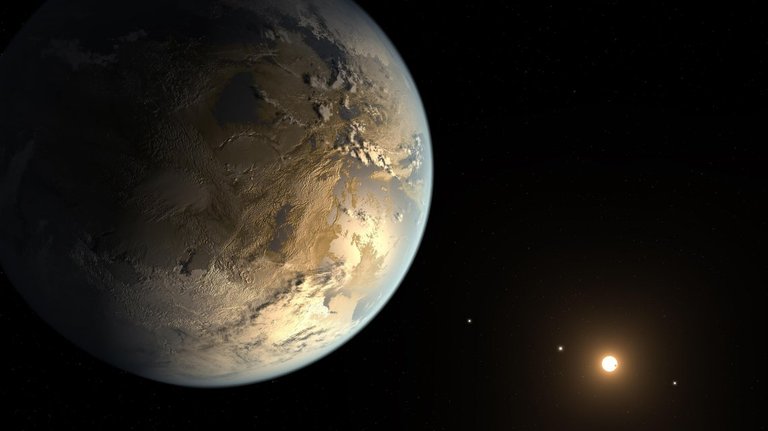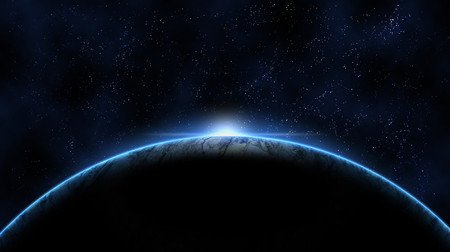We live in an exceptional time when finding a potentially habitable planet around a star is becoming commonplace. The last one is Ross 128 b, a planet with a minimum mass of only 1.35 times that of the Earth located in the habitable zone of a red dwarf of spectral type M4 (with 15% of the mass of the Sun). The wonderful thing is that Ross 128, also known as Proxima Virginis, GJ447 or HIP 57548, is only eleven light years from the solar system. Ross 128 b is therefore the second closest exotier to Earth after Proxima b.
Ross 128 b has been discovered using the radial velocity method by, of course, the famous HARPS spectrograph of the 3.6-metre telescope at La Silla (Chile). Specifically, 157 observations were carried out between 2005 and 2016. This method only gives us information about the period of translation of the planet and its minimum mass. In the case of the period, that is, the year, it is only 9.9 days. Despite being so close to its star -7.4 million kilometres-, Ross 128 b is in the habitable zone. Or, as we say by Radio Skylab, the water zone. More than anything because we can't know whether the planet is habitable or not, only that, given the right conditions, there could be liquid water on its surface.
Assuming a range of normal -albedos- brightness, Ross 128 b would have a surface temperature between -60 ºC and 21 ºC. These are not low temperatures because we remember that the Earth's equilibrium temperature is about -20 ºC. The presence of an atmosphere around our planet is responsible for raising the average surface temperature above the triple point of water. In fact, according to the most conservative models Ross 128 b would be close to the inner limit - warmer - of the habitable zone, something that is also not negative per se since the Earth is in the same position. Naturally, depending on the actual parameters of albedo and atmospheric composition, among others, it may well be totally outside the habitable zone and more like Venus than Earth. Of course, as far as we know, it could also be a bare rock devoid of any atmosphere and there is even the possibility -extremely low, but not nula- that it is not a rocky planet and in reality we are in front of a minineptune (the radial velocity method only gives us the minimum).
What we can be sure of is that, even if it is potentially habitable, Ross 128 b will not look like Earth. It will most likely suffer from tidal coupling, that is, it always shows the same hemisphere towards its star. In other words, a world where on one side it is always daytime and on the other side it is always nighttime. The other catch is that it revolves around a red dwarf, a type of star famous for its violent ejections of particles and intense ultraviolet and X-ray emissions in the form of bursts that can strip a planet from its atmosphere very easily. But, and watch out, because this is very interesting, Ross 128 is a very quiet red dwarf, unlike Proxima Centauri or TRAPPIST-1, so the planet Ross 128 b should not have such an intense magnetic field to protect its atmosphere.
Ross 128, located in the constellation Virgo, is in fact the 12th star closest to the solar system and, if we wait about eighty thousand years, it will become the nearest star, since by then it will be just over six light years from Earth (meanwhile the triple system of Alpha Centauri will have moved away from us). Its name comes from the catalogue created by the American astronomer Frank E. Ross, although it also appears in the famous catalogue of Gliese and Jahreiß with the designation of GJ 477. It is an old star and, although determining the age of a red dwarf is a complex task, it is believed to have more than five billion years based on its low metallicity, which in turn explains its low fieriness. Precisely the discoverers of Ross 128 b have had to carefully measure the brightness of Ross 128 to verify that the variability characteristic of the red dwarfs has not interfered with the measurements of radial velocity. Independent observations have been used, including some from the Kepler space telescope in its K2 extended mission.
Unfortunately, Ross 128 b does not transit, that is, it does not pass in front of its star. This means that we will not be able to obtain transmission or occultation spectra of its atmosphere with terrestrial telescopes or the future James Webb. The good news is that, as in the case of Proxima b, its extreme closeness will allow it to be seen directly by the future giant telescope E-ELT. And not only that, this giant telescope -and others- will be able to observe the spectral bands corresponding to the oxygen in the visible one (that yes, with about sixty nights of observations), so if the atmosphere of this world possesses this element we will know it throughout the next decade.
Ross 128 b adds to the potentially habitable worlds discovered around red dwarfs such as Proxima b, the planets of TRAPPIST-1 and LHS1140b. But, since theoretical models point out that both TRAPPIST-1 and Proxima are very active stars with energetic outbursts dangerous for any form of life, Ross 128b may well be the closest exotier to Earth with the probability of harboring life. But on a personal level the most amazing thing of all is that we have discovered all these inhabitable exoplanets in the space of practically a single year. What will we discover in the coming decades?



I upvoted your post.
Mabuhay, keep steeming.
@Filipino
Posted using https://Steeming.com condenser site.
Great to know about Ross 128 system, mostly about Ross 128b the exo-super Earth. Thanks for sharing such a great information.